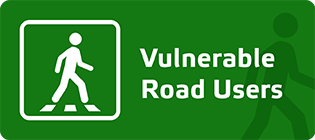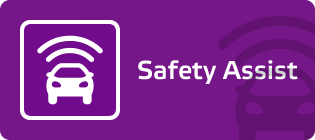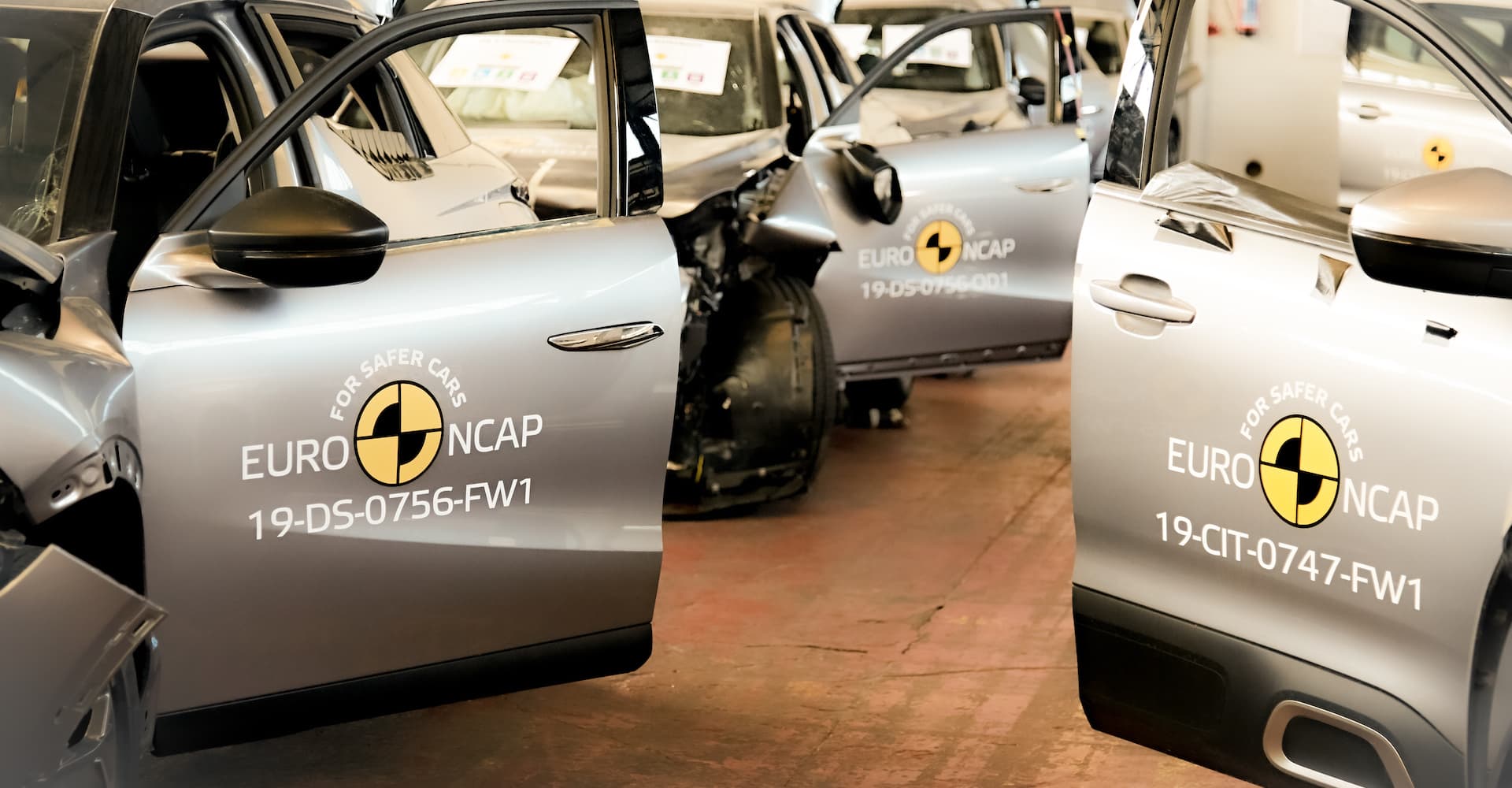New cars are safer than ever, and are getting safer every year. More technology to help drivers stay safe is being included in vehicles at all price points, while manufacturers continue to find new ways to improve the safety of their cars.
To help consumers understand how safe new cars really are, an independent testing organisation called Euro NCAP gives new cars from Europe ratings for how well they avoid accidents and protect in an impact. However, all the information can be a bit tricky to understand at times, which is why we’ve put together this guide that explains what it all means in plain English.
The UK is part of Euro NCAP (European New Car Assessment Programme) – in fact, Euro NCAP was established by the UK’s Transport Research Laboratory (now called TRL) on behalf of the Department for Transport in 1997. Today, management of the organisation is handled from Brussels while UK testing is undertaken by Thatcham Research.
Euro NCAP is based on an American programme called NCAP, and similar sister organisation have launched in other parts of the world, including Australia (ANCAP) and China (C-NCAP). There is also a global organisation (Global NCAP), also based in the UK, that concentrates on improving car safety in developing countries. Through its 14 member bodies like Thatcham Research, Euro NCAP thoroughly crash tests a large number of new cars each year and awards an overall rating depending on how well a car meets certain safety criteria.
Here at The Car Expert, we firmly believe that safety is a core component of any new car. Unlike most new car reviews elsewhere that only report the headline score and don’t bother updating it over time, our unique Expert Rating analysis includes the full Euro NCAP results for all cars tested and is kept up to date as ratings change or expire. We’ll explain below why we think this is so important.
Euro NCAP star rating system
Euro NCAP safety ratings are easy to recognise, and are based on a simple five-star system. Five stars is best, zero is the worst and there are no half-star ratings. Pleasingly, most new cars these days tend to score four or five stars, and it tends to be more newsworthy when a new car doesn’t actually score top marks – as happened this week when the Renault Zoe scored zero stars.
The testing standards go above and beyond minimum legal requirements, so a car can perform dismally in Euro NCAP testing but still meet legal requirements in the UK and across Europe – as well as the Renault Zoe scoring zero stars in 2021, the Fiat Panda scored zero stars in 2018. Despite these abysmal results, they’re both still on sale and perfectly legal. However, if you were a customer comparing two new cars – one with a five-star safety rating and the other with a zero-star rating – it would be difficult to justify picking the zero-star car.
Testing processes are also upgraded regularly, with minor enhancements each year and significant changes implemented every few years. This means that a five-star rating awarded a few years ago is not necessarily equivalent to a five-star rating awarded today.
Euro NCAP reviews the results of previous tests on an annual basis, and ratings will eventually expire when a car no longer meets the requirements to maintain its original rating against newer testing standards. For example, the Citroën C1 was tested back in 2014 and was awarded a four-star rating. However, this rating expired in January 2021 as it no longer met the criteria for a five-star car. With this expiry, the C1 effectively has no current safety rating.
Sometimes a car will be re-tested after several years on sale: the Volkswagen Up was tested in 2011, when it was first launched, and scored five stars. However, standards have evolved and the same model was tested again in 2019, with the result being that it was downgraded to only three stars.
Once a rating expires, a car manufacturer can no longer promote a car’s Euro NCAP score, but unfortunately the motoring media rarely update their reporting to reflect this.
Older ratings are obviously still important if you are looking at buying an older car, and the results for all tests remain available on the Euro NCAP website.
Here at The Car Expert, we regularly check the Euro NCAP database to remove ratings that have expired from our Expert Rating reports. We still provide a link to the original safety rating on the Euro NCAP website, but we make it very clear that the rating is no longer valid. We are the only UK automotive site that does this.
Which cars are tested?
Not every new car is put through the Euro NCAP safety testing protocol. It’s not compulsory and Euro NCAP can’t afford to test every new car on the market. The testing process requires four cars, all of which will be written off in high-impact collisions. That tends to rule out the organisation purchasing a few Bentleys or Lamborghinis to crash into walls and poles.
On top of the costs of the cars themselves, the cost of conducting the tests and maintaining the laboratories is substantial, so it’s simply not possible to assess every new car. As a result, the organisation has to decide which cars it will choose to test. This inevitably means taking the most popular models on sale, and cheaper rather than more expensive models.
In addition to cars that Euro NCAP purchases with its own money, car manufacturers can submit vehicles for testing. This usually happens when a new model is released (and when a car company is confident of achieving a good score), so that the manufacturer can – hopefully – promote a five-star rating as soon as the new model goes on sale.
Euro NCAP works with the car companies to make sure it is testing the most popular and most representative variants, and usually a rating will apply across all versions of that model sold across all European markets (including both left-hand drive and right-hand drive) and across different body styles.
For example, the Audi A4 has a five-star rating based on Euro NCAP testing of the saloon model. The scores apply to the estate versions as well because the cars are structurally identical for the purposes of testing – and Audi was required to show evidence of this to Euro NCAP in order for the rating to be applied to all models. Incidentally, the Audi A4’s rating also applies to the A5 coupé and A5 Sportback models as they are also structurally identical, but not the A5 Cabriolet, which has substantial differences (not having a roof, and the alterations required to the rest of the car to compensate for that).
There are circumstances where ratings only apply to specific versions of a car. For example, the Hyundai Kona has a five-star rating that applies to all petrol, diesel and hybrid models. However, that score does not apply to the Hyundai Kona Electric model, as there are too many changes to the vehicle that would affect how it performs in the tests.
Dual ratings
In 2016, Euro NCAP introduced the concept of a dual rating, as many cars have advanced safety equipment that may only be available on more expensive trim levels or as an extra-cost option. As a result, an entry-level model may not perform as well as a top-spec version of the same vehicle.
In such cases, Euro NCAP will run separate tests for cars with and without the additional safety equipment, and will award separate ratings. The first score reflects the car’s safety levels when fitted with standard equipment. According to Euro NCAP, it ‘reflects the minimum amount of safety you can normally expect from any car sold anywhere in the European Union’. The second rating reflects cars fitted with an additional safety pack available at extra cost.
An example of this is the Peugeot 2008, where the lower-spec ‘Active’ and ‘Active Premium’ models are not fitted with certain safety kit, and as a result they only get a four-star rating. Higher-spec models have this extra kit included, so they get a five-star score.
Some cars, like the Nissan Micra, have two separate ratings from Euro NCAP (four stars and five stars, depending on specification) but all models sold in the UK get the full suite of safety equipment as standard, so all UK-spec Nissan Micras are rated five stars while those in Europe may have a lesser score.
Here at The Car Expert, our Expert Rating reports will always display the standard rating for entry-level UK-spec cars in full, with additional notes about extra safety kit being available and a link to any separate Euro NCAP rating for cars with the extra kit. So for the Peugeot 2008 example above, we show the car as having a four-star rating, regardless of how many models are sold in that specification.
The four rating categories
The Euro NCAP rating is based on four separate categories, covering adults, children, vulnerable road users and safety assistance systems. All four scores are expressed as a percentage.
Adult occupancy protection
Adult occupancy measures how safe both an adult driver and front passenger are kept in the event of an accident. Tests are conducted for frontal impact, side impact and whiplash.

Child occupant protection
Child occupant testing measures how safe children are kept in the rear seats in the event of a crash. Euro NCAP uses crash test dummies to represent children six and ten years of age, and also assesses mounting points for child seats.

Vulnerable road user protection
Previously called pedestrian protection, this section was expanded in recent years to include cyclists. The purpose of the tests is to assess the potential injuries to a pedestrian’s head, pelvis, upper and lower leg in an impact.
Cars gain additional points if they have an autonomous emergency braking (AEB) system that recognises both pedestrians and cyclists.

Safety assist
Safety assistance systems that help avoid an accident (or at least reduce the impact) have improved massively over the last decade. Euro NCAP has placed increasing importance on this technology in recent years – after all, it’s better to avoid an accident altogether than to survive one.
The testing measures systems for autonomous emergency braking, speed limit assistance, land-keeping assistance, seatbelt warnings and driver fatigue detection.

Why all four scores are important
The headline star rating gives a good overall picture for each car, but it doesn’t necessarily provide the best answer for every situation as not every score will be relevant to every buyer.
A good example of this is the Ford Mustang. In 2017, the Mustang was widely criticised after scoring a dismal two stars in Euro NCAP testing. Essentially, it performed reasonably well for adult occupants but was poor in the other three tests – particularly for child protection. Ford quickly made some specification changes to the car, adding improved autonomous braking to benefit vulnerable road users and avoid rear-end collisions, and resubmitted the Mustang to Euro NCAP for a second round of testing.
In the new tests, the Mustang improved to a three-star score – better, but still a poor overall result. However, by looking at the four individual categories it becomes clear that the Mustang improved considerably in the vulnerable road user and safety assist scores, while adult occupant protection remained the same. The main weakness remained child protection in the rear seats, which was something that Ford was unable to suitably rectify without a wholesale redesign.
So if you have kids, a Mustang is probably one of the worst new cars you could buy to protect them. But if you don’t ever intend to put children in the back seats, the Mustang is a much safer car than its three-star rating suggests. Personally, I’d happily drive a Mustang myself but I wouldn’t buy one for our household as I have a five-year-old son who would be riding in the back several times a week.
Similarly, vulnerable road user protection is a much bigger issue for driving in city environments where there are lots of pedestrians and cyclists, compared to many rural settings where there may be very few. In terms of safety assistance systems, driver fatigue systems won’t really register if you only ever take short journeys. Speed assistance systems are particularly beneficial if you don’t know the local speed limits, but less so if you tend to only travel on the same roads for most of your journeys.
All four categories measure different aspects of a car’s overall safety, but not every buyer needs their car to do well in all of those tests. That’s why our Expert Rating reports show all four scores for each car, allowing you to see the full picture and make the best decision for your needs.
This article was originally published in June 2020, and most recently updated in December 2021 with new information. Additional reporting by Jack Evans, PA Media












